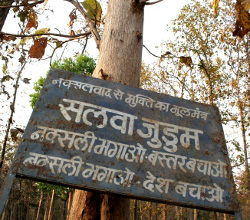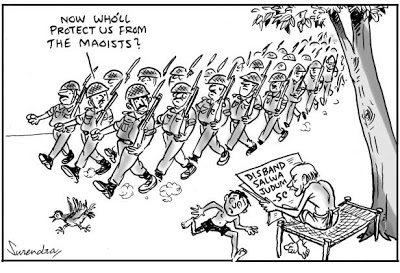A fact finding team from People’s Union for Civil Liberties reveals the extent of Salwa Judum’s terror; National Human Rights Commission directs PUCL to investigate the allegations further

In a letter dated 16 June 2017, The National Human Rights Commission (NHRC) directed the People’s Union of Civil Liberties (Chhattisgarh) to make further inquiries into a complaint it had received regarding the looting and burning of huts and the killing of seven persons of Kondasawali, a village in district Sukma of Chhattisgarh.
Sometime during the years 2006–2007, there was an increase in the presence of the members of Salwa Judum, a local militia aimed at “countering” Naxalite violence, in the hills surrounding the Kondasawali village. According to the testimonies collected, they regularly harassed the villagers; looted and burnt village property; beat up the villagers; and sexually assaulted women. Because of this, most of the villagers fled from their homes. While a few went to Bailadila, Andhra, and other nearby areas to look for work, the rest lived in the forest. Those living in the forests survived on whatever the people from nearby villages gave them, and the little that they could forage in the forest. A number of them died because of the harsh living conditions there. Around 2009–10, when Salwa Judum was starting to lose its influence in the area, the villagers started returning. It is around this period that a group of about 60-80 Selwa Judum leaders, SPOs, and the state force, attacked, burnt and looted three settlements in the Kondasawali Gram Panchayat i.e. Karrepara, Kamaraguda, and Kondasawali. About 95 huts were burnt and seven people killed. In 2011, the Supreme Court declared the Salwa Judum illegal and unconstitutional and ordered its disbanding.

By 2013, the surviving villagers had returned and were well on their way to rebuilding their homes and tilling their lands. Because enough time had passed since the last incidence of violence, the villagers felt that it was now safe enough to file a complaint against the perpetrators who had pillaged the village and killed seven people. Finally, the then Sarpanch of Kondasawali, Sandam Sannu, filed an official complaint to the Collector on 12 July 2013. Following this, on 13 August 2017, Barse Nande, a villager, was attacked and killed by the security forces. She had been one of the key complainants in the case, as her husband, Barse Nanda, was one of the seven people who had been killed in the 2009–10 violence. Fearing that this was an act of retribution for filing the complaint, and worried about any further violence or killings against the complainants, Sudha Bhardwaj, on behalf of the Chhattisgarh chapter of PUCL, took up the matter with the National Human Rights Commission (NHRC).
The report, prepared by PUCL and submitted to the NHRC says, “A delegation of the PUCL also met the Inspector General of Police and Commissioner, Bastar Division, Jagdalpur on 13 September 2013, and apprised them of the case.” On 16 June 2017, the NHRC wrote to Sudha Bhardwaj, and asked her to visit Kondasawali as the General Secretary of the Chhattisgarh PUCL, and gather more information regarding the incident and the complaint. Being unable to visit the area personally, Bhardwaj request Soni Sori’s help, a human rights defender. Sori, along with JK Vidhya, a researcher, formed a fact finding team that could go to Kondasawali Gram Panchayat. Bhardwaj wrote to Sumedha Dwivedi, Senior Superintendent of Police (SSP) of NHRC, informing her of the same.
Ultimately, an eight member fact finding team — comprising Soni Sori (human rights defender), JK Vidhya (researcher), Lingaram Kodopi (human rights defender), Sukul Prasad (human rights defender), Danti Poyim (interpreter), Pushpa Rokde (journalist), Nitin Rokde (journalist), and Soni Sori’s guard and PSO — was put together. Due to various unavoidable delays, the team finally managed to visit the village on 21st–22nd August 2017.
Once there, they got in touch with the erstwhile Sarpanch who had filed the original complaint, and he sent word to all the villages in the Kondasawali Gram Panchayat that anyone willing to give their testimonies or speak to the team could come to a specific common ground the next day.
A sizable crowd had gathered there the next day. The report says, “After a brief discussion with everyone present, it was decided that each person who lost a family member during the incidents in 2009-10 and 2013 would testify on camera. Following their testimony, all those present from the three [settlements] where homes were burnt would testify collectively on camera. And finally, after that, all those present could speak up if they wished to do so.”
Among those who gave their testimonies to the fact-finding team sent by PUCL (Chhattisgarh), there were people who could name and recognise at least a handful of those who were responsible for the violence. One of the primary demands of the villagers is that these men be removed from their posts in the government and be punished for their role in the incident. The report lists other demands as well: “The villagers of Gram Panchayat Kondasawali gathered together and prepared a list of demands. They read out these demands in public which has also been recorded by the team. The team assured the villagers that the same would be conveyed to the NHRC though they did not all strictly pertain to the complaint that the team had come to enquire into.”
The team then submitted all their findings, testimonies, observations, along with all the videos and relevant documents, to the PUCL. A report detailing the entire matter, from the complaint originally launched, to the fact finding team’s visit, was written by Sudha Bhardwaj and JK Vidhya, and submitted to Sumesha Dwivedi, SSP NHRC. Al the findings of the fact-finding team, including the video testimonies, their observations, and other documents, were submitted along with this report.

The NHRC has come out with an order. It says, “The Commission concludes that these incidents had come to the notice of police, revenue and other officials of District Sukma soon after they had taken place but police and district officials had deliberately turned a blind eye to these killings and incidents of arson.”
(Courtesy: Indian Cultural Forum)



